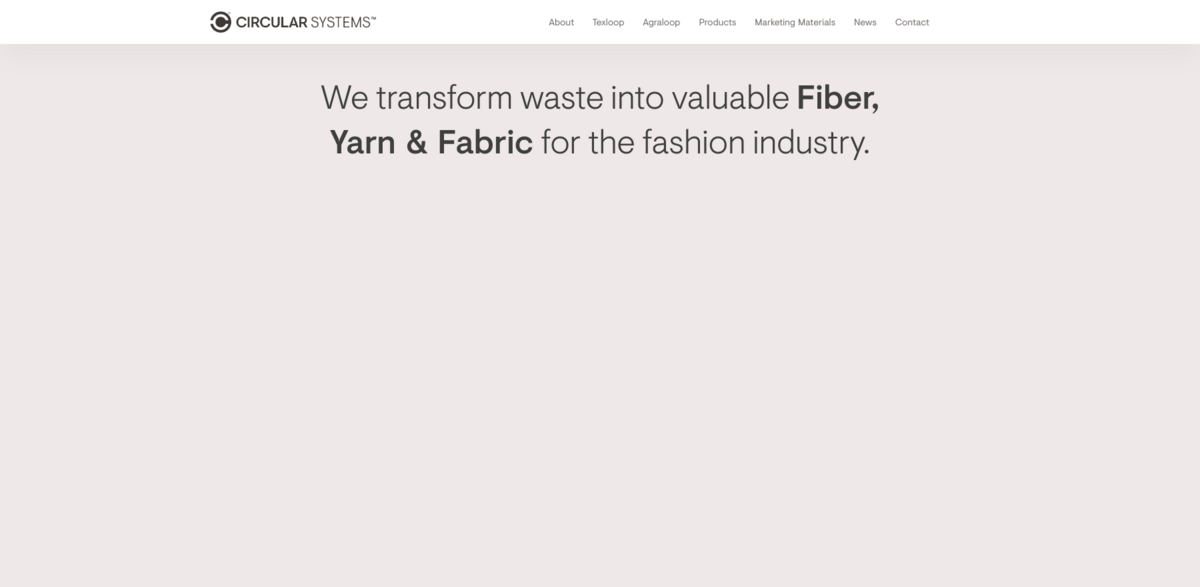What is Circular Systems?
Circular Systems transforms waste into valuable fiber, yarn & fabric for the fashion industry. This materials science company is laser-focused on developing innovative circular and regenerative technologies through its waste-to-fiber platforms, Texloop™ and Agraloop™, alongside its proprietary Orbital™ Hybrid Yarn technology. It’s a bold concept that turns discarded textile and agricultural waste streams into high-quality inputs for fashion products… all while retaining the maximum embedded energy from those waste streams.
Main Benefits and Key Figures
- Breakthrough waste-to-fiber platforms: Texloop™ ensures the lightest touch processing, preserving fiber quality for next-generation recycled materials.
- Agraloop™ refines natural fibers from agricultural crops into textile-grade fiber, known as Agraloop™ BioFibre™.
- Patent-pending Orbital™ Hybrid Yarn technology enables the creation of high-performance, natural-fiber-rich materials.
- FibreTrace® offers full supply-chain transparency, giving textile brands a 20/20 vision from raw fiber to the finished product.
- Supports all 17 United Nations Sustainable Development Goals, benefiting economics, society, and the environment.
Innovative Circular and Regenerative Technologies
Circular Systems distinguishes itself with a complete family of circular and regenerative products. Its Lightest Touch™ philosophy drives the mission to preserve the energy embedded in waste inputs while generating the highest-value outputs possible. With Texloop™, recycled fiber is created from textile waste, and with Agraloop™, crop residues are transformed into high-quality BioFibre™. This robust approach in materials science not only redefines waste streams but also establishes scalable solutions for the circular economy… a truly forward-thinking, sustainable initiative.
Sustainable Fashion: Waste to Fiber Transformation
The transformative journey begins with waste – whether textile waste or agricultural residue – which is reimagined as a valuable resource. Through the innovative processes embedded in Texloop™ and Agraloop™, waste is refined and optimized. The result is high-value fiber, yarn, and fabric that can be seamlessly integrated into conventional yarn spinning systems to produce elegant fashion products. This conversion of waste into sustainability not only reduces environmental impact but reinvents how industries view resource efficiency, making each step a testament to creative, environmentally conscious innovation.
Integrated Supply Chain and Traceability
FibreTrace® serves as a pivotal tool by providing complete transparency throughout the entire supply chain. This technology gives textile brands and suppliers an exact view from raw fiber to the store shelf. The integration of FibreTrace® with both the Texloop™ and Agraloop™ processes ensures that every step is tracked, secure, and efficient. It’s all about establishing trust, accountability, and continuous improvement in the supply chain process… ensuring that sustainability goes hand in hand with performance and reliability.
Social and Environmental Impact
Circular Systems stands out by directly supporting all 17 Sustainable Development Goals established by the United Nations. This commitment goes beyond reducing waste – it’s about reimagining how industries can have a net-positive impact on both habitat and humanity. By partnering with industry allies, local NGOs, and regional governments, the initiative supports projects aimed at circular resource efficiency, greenhouse gas reduction, carbon sequestration, and soil regeneration. This multifaceted approach integrates systemic solutions that drive beneficial socio-economic impacts as much as environmental ones.
Project Impact on Global Sustainability
- SDG 1: No Poverty
- SDG 2: Zero Hunger
- SDG 3: Good Health and Well-being
- SDG 4: Quality Education
- SDG 5: Gender Equality
- SDG 6: Clean Water and Sanitation
- SDG 7: Affordable and Clean Energy
- SDG 8: Decent Work and Economic Growth
- SDG 9: Industry, Innovation and Infrastructure
- SDG 10: Reduced Inequalities
- SDG 11: Sustainable Cities and Communities
- SDG 12: Responsible Consumption and Production
- SDG 13: Climate Action
- SDG 14: Life Below Water
- SDG 15: Life on Land
- SDG 16: Peace, Justice and Strong Institutions
- SDG 17: Partnerships for the Goals
Future Directions in Circular Innovation
The journey of Circular Systems continues to inspire a shift in how the world perceives waste. Its groundbreaking platforms, Texloop™ and Agraloop™, are more than just technologies – they are a catalyst for changing the narrative around sustainability in the fashion industry. Casual conversations in boardrooms and eco-conscious communities alike now often turn to the potential of regenerative technologies that create systemic solutions for resource management. With each innovation, there is a growing anticipation of future projects that will build upon these successes and scale up positive environmental and socio-economic impacts globally… setting new standards for what is possible in a circular economy.





















